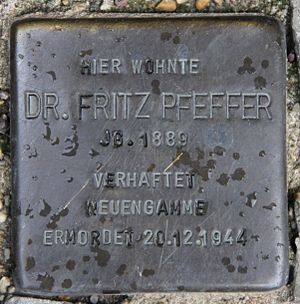Fritz Pfeffer facts for kids
Quick facts for kids
Fritz Pfeffer
|
|
|---|---|
 |
|
| Born | 30 April 1889 |
| Died | 20 December 1944 (aged 55) Neuengamme concentration camp, Hamburg, Nazi Germany
|
| Nationality | German |
| Education | Medical |
| Occupation | Dentist |
| Known for | The Diary of a Young Girl by Anne Frank |
| Height | 6'2 |
| Spouse(s) | Vera Bythiner (m. 1926; div. 1932) |
| Partner(s) | Charlotte Kaletta (1936–1944) |
| Children | 1 |
Friedrich "Fritz" Pfeffer (born April 30, 1889 – died December 20, 1944) was a German dentist. He was also a Jewish refugee who hid with Anne Frank and her family. This happened during the time the Nazis controlled the Netherlands. Sadly, he died in the Neuengamme concentration camp in Northern Germany. In Anne Frank's famous diary, Pfeffer was given the pseudonym (a made-up name) Albert Dussel. Many versions of the diary still use this name for him.
Fritz Pfeffer's Early Life
Fritz Pfeffer was born in Giessen, Germany. He was one of six children. His family lived above their clothing shop. After finishing school, Pfeffer trained to be a dentist and jaw surgeon. He got his license in 1911 and opened his own practice in Berlin the next year. He also served in the German army during the First World War.
In 1926, Pfeffer married Vera Bythiner. They had a son named Werner Peter Pfeffer. However, they divorced in 1932. Fritz was given custody of his son and raised him alone. By November 1938, the Nazis were becoming more powerful in Germany. Because of this, and an event called Kristallnacht, Fritz sent his son to live with his brother Ernst in England. Werner later moved to California in 1945. He changed his name to Peter Pepper and started a successful office supplies company.
The rise of antisemitism (hatred towards Jewish people) in Germany forced many of Pfeffer's relatives to leave the country. His mother had died earlier. His father stayed in Germany but was later arrested and died in Theresienstadt in 1942. His sister Vera escaped to the Netherlands but was also arrested and died in Auschwitz.
In 1936, Fritz met Charlotte Kaletta. They moved in together. However, they were not allowed to marry because of the 1935 Nazi Nuremberg Laws. These laws made it illegal for Jewish people and non-Jewish people to marry.
The events of Kristallnacht made Fritz and Charlotte decide to leave Berlin. They moved to Amsterdam in December 1938. They lived there for two years before Germany invaded. New anti-Jewish laws then forced them to live at different addresses. Fritz opened a dental practice in Amsterdam. There, he met the van Pels and Frank families. Miep Gies, who later helped hide the families, became his patient.
Hiding from the Nazis
In the autumn of 1942, Fritz Pfeffer decided he needed to go into hiding. He asked Miep Gies for help. Miep talked to Otto Frank, whose family was already hiding in secret rooms in their office building. The Van Pels family was also hiding there. Otto Frank agreed to let Pfeffer join them. Fritz Pfeffer moved into the hiding place on November 16. His medical knowledge was very helpful to the families, as they could not see a doctor while in hiding.
To make room for Fritz, Margot Frank moved into a room with her parents. This allowed Fritz Pfeffer to share a small room with Anne.
Fritz left a goodbye note for Charlotte. They stayed in touch through Miep Gies, who would meet Charlotte weekly. Miep would exchange their letters and bring supplies. Fritz's letters never revealed where he was hiding, and Miep never told anyone. However, on August 4, 1944, Fritz and the seven other people in hiding were arrested. They were taken away to Nazi concentration camps.
Fritz, along with the others and two of their helpers, Johannes Kleiman and Victor Kugler, were first taken to a Nazi headquarters. Then they were moved to a prison for three days. On August 8, they were sent to the Westerbork transit camp. Fritz was put in the Punishment Barracks and forced to do hard labor. On September 3, he was chosen to be sent to Auschwitz.
When he arrived at Auschwitz on September 6, he was separated from the others. He was sent to the men's barracks, where he met Otto Frank again. On October 29, Fritz was moved to Sachsenhausen with 59 other medical workers. From there, he was transferred to Neuengamme. According to the camp's records, Fritz Pfeffer died in the infirmary there on December 20, 1944. He was 55 years old.
What Happened After
After Fritz Pfeffer's death, Charlotte Pfeffer officially married him in 1950. This marriage was made to count from May 31, 1937. She later grew apart from Fritz's son, Werner.
Werner Pfeffer stayed in touch with Otto Frank. He also met Miep Gies shortly before he died in 1995. He thanked her for trying to save his father. This meeting was filmed for a documentary called Anne Frank Remembered.
A collection of letters Fritz Pfeffer wrote to Charlotte, along with some photos of him, were found after Charlotte's death in 1985. They were rescued from an Amsterdam flea market.
The actor Ed Wynn played Fritz Pfeffer (as Dussel) in the 1959 film The Diary of Anne Frank. He was nominated for an Academy Award for his role.
See also
 In Spanish: Fritz Pfeffer para niños
In Spanish: Fritz Pfeffer para niños
- Betrayal of Anne Frank
- People associated with Anne Frank


